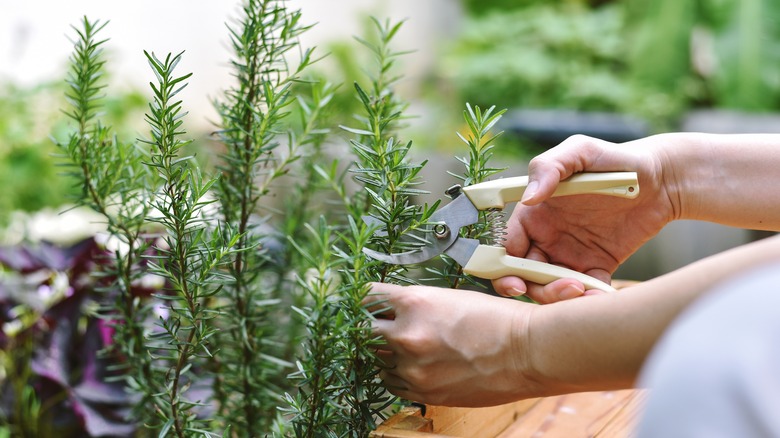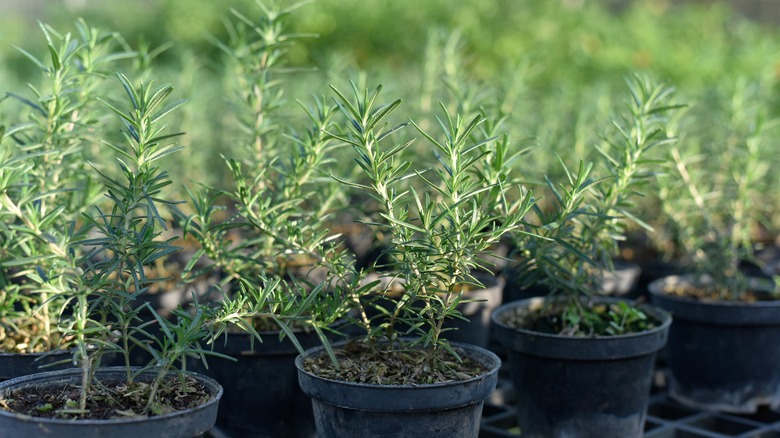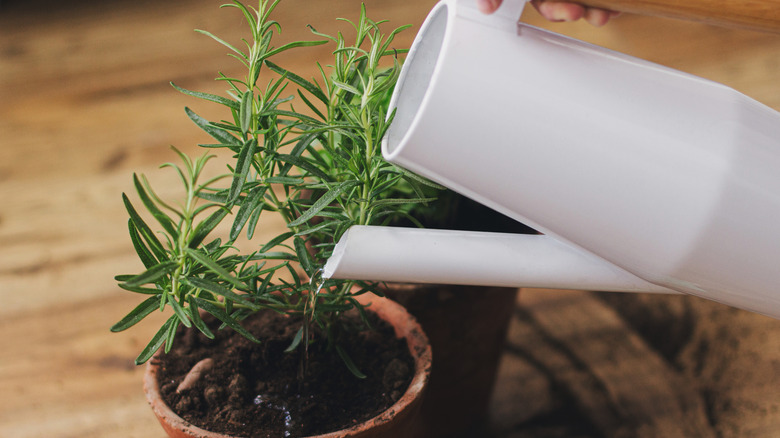Why Your Rosemary Is Turning Brown (And What To Do About It)
Few things in home gardening can rival the refreshing aroma of a rosemary plant (or, as the scholarly botanists label it, Salvia rosmarinus) wafting through your outdoor or indoor space. Renowned for its drought tolerance, this small to medium-sized shrubby herb makes perfect companions with other Mediterranean herbs like lavender. The ease with which it roots from cuttings makes it a blessing for aspiring green thumbs. And besides how it gloriously straddles between herbs and shrubs categories, we can't afford to overlook its starring role in the culinary and wellness realms. However, despite this bright disposition, rosemary could fall into the hands of the ominous browning syndrome.
So, why is your rosemary turning brown? As your heart sinks, the likely culprits raise their heads — excess moisture in the soil, underwatering, a moisture-heavy atmosphere, sunburn, insufficient sunlight, and cramped roots. "But is my rosemary dead?" you might ask. It's time to roll up our sleeves and investigate, whether plunging your fingers into the soil for any sign of dampness, inspecting the area for a humidity siege, or confirming the sunlight's reach to the plant. This little sleuthing will help uncover the mystery behind your rosemary's premature browning and set you on the path to reviving it.
Reasons why your rosemary is turning brown
Let's play Sherlock on the browning mystery, starting with the case of an overzealous gardener showering their rosemary plant with H2O. Rosemary has a shallow root system, and overwatering it invites moisture-loving pathogens for a squelching party in the roots. Before you know it, you're looking at a mushy, rotten root system that compromises water and nutrient uptake, resulting in brown-tipped, droopy leaves. Unsurprisingly, underwatering wields equal power in the rosemary-browning saga. A brittle, dry rosemary with stems that easily snap signifies dehydration.
Humidity could fan the flames — figuratively, of course — since rosemary thrives in open spaces with good airflow. Otherwise, fungal diseases such as botrytis blight and powdery mildew inch their way in, leaving their autographs in the form of brown leaves and gray residue. About sunlight: Rosemary likes low-light settings, embracing at least six hours of shade daily. Excess sunbathing may cause browning, whereas too much shade prevents soil from drying out, driving our green protagonist back to overhydration-related issues. And did you know those nutrient booster shots you've been administering to your rosemary might be doing more harm than good? Yes, they could trigger a fertilizer burn that can paint your plant brown. Also, sneak a peek for unanticipated guests like aphids and spider mites. These feast on your rosemary, leaving a trail of brown as their signature.
How do you revive a brown rosemary plant?
There's still a chance for redeeming a rosemary that's turning brown. In the murky world of overwatering and root rot, it's all about balance. Tone down your watering frequency to once every two weeks. As a bonus precaution, verify that your rosemary pot drains well and only water when the soil is dry. However, watering rosemary in winter is an engraved invitation to root rot. If slow-draining soil is the suspect, it's time for grand house-moving. Picture a new pot glammed with 80% potting soil or compost and 20% sand or grit. But first, channel your inner surgeon and excise any infected roots or stems — rotten apples are off-limits here. Disinfect pruners between cuts and discard cut pieces to avert fungal mayhems.
Reviving dehydrated rosemary boils down to timely watering and a rejuvenating cocktail of liquid fertilizer. And what of excess humidity? Ensure a 2-3-foot space between your plants for proper ventilation. As for those pesky pests, shower your plants using a garden hose or spray with neem oil or insecticidal soap if the invaders persist. Now, onto sunlight woes. Shelter a scorched, potted rosemary indoors or cast a shadow using a tree branch or shade fabric. For the unfortunate sunlight-starved ground-planted rosemary, orchestrate a decent trimming of nearby vegetation or transplant it to a sun-soaked spot. A sun-deprived, housebound rosemary will appreciate relocation to a sunlit, south-facing window. Tending to fertilizer-burnt rosemary? Lower your feeding zeal.


